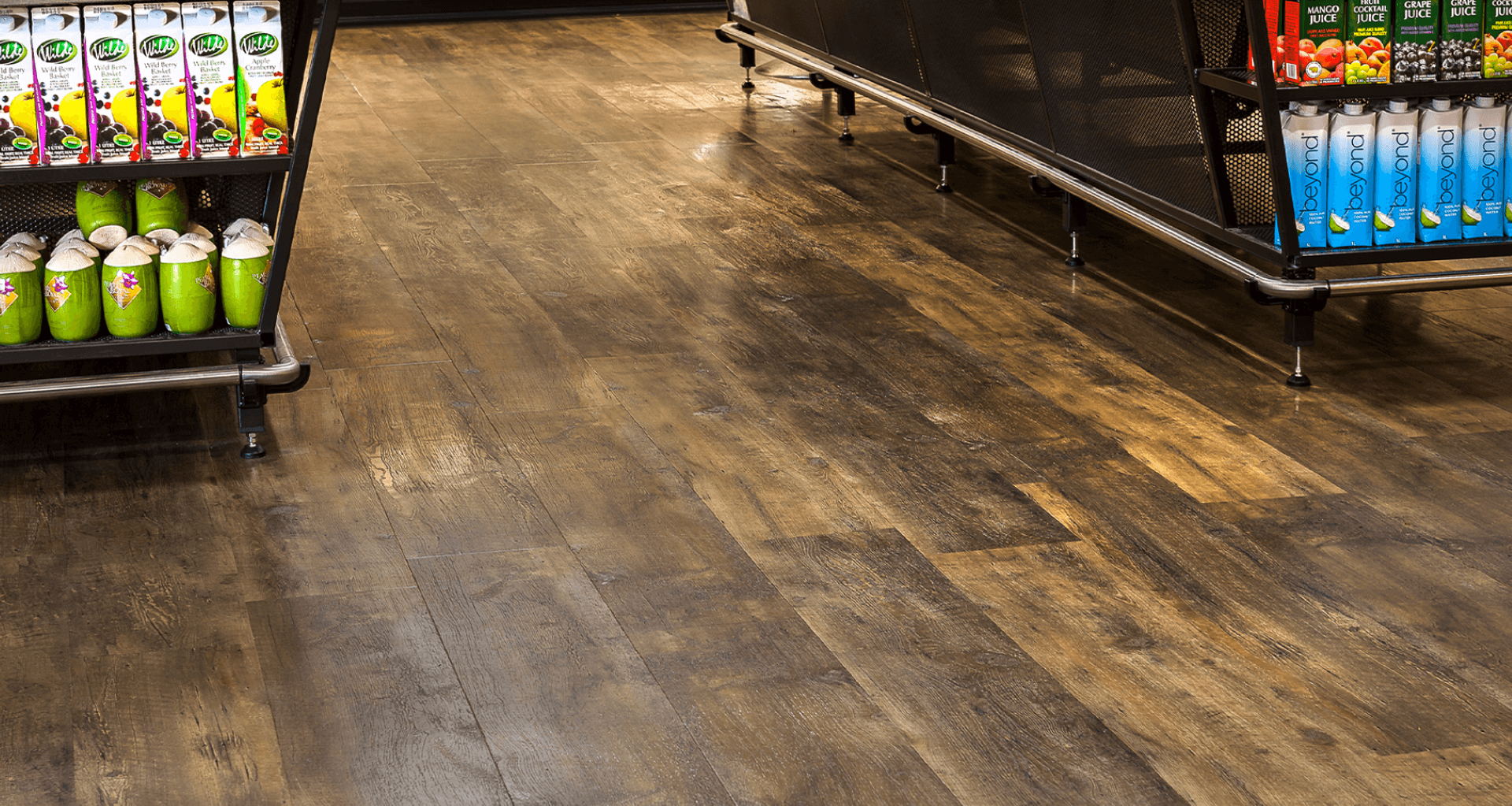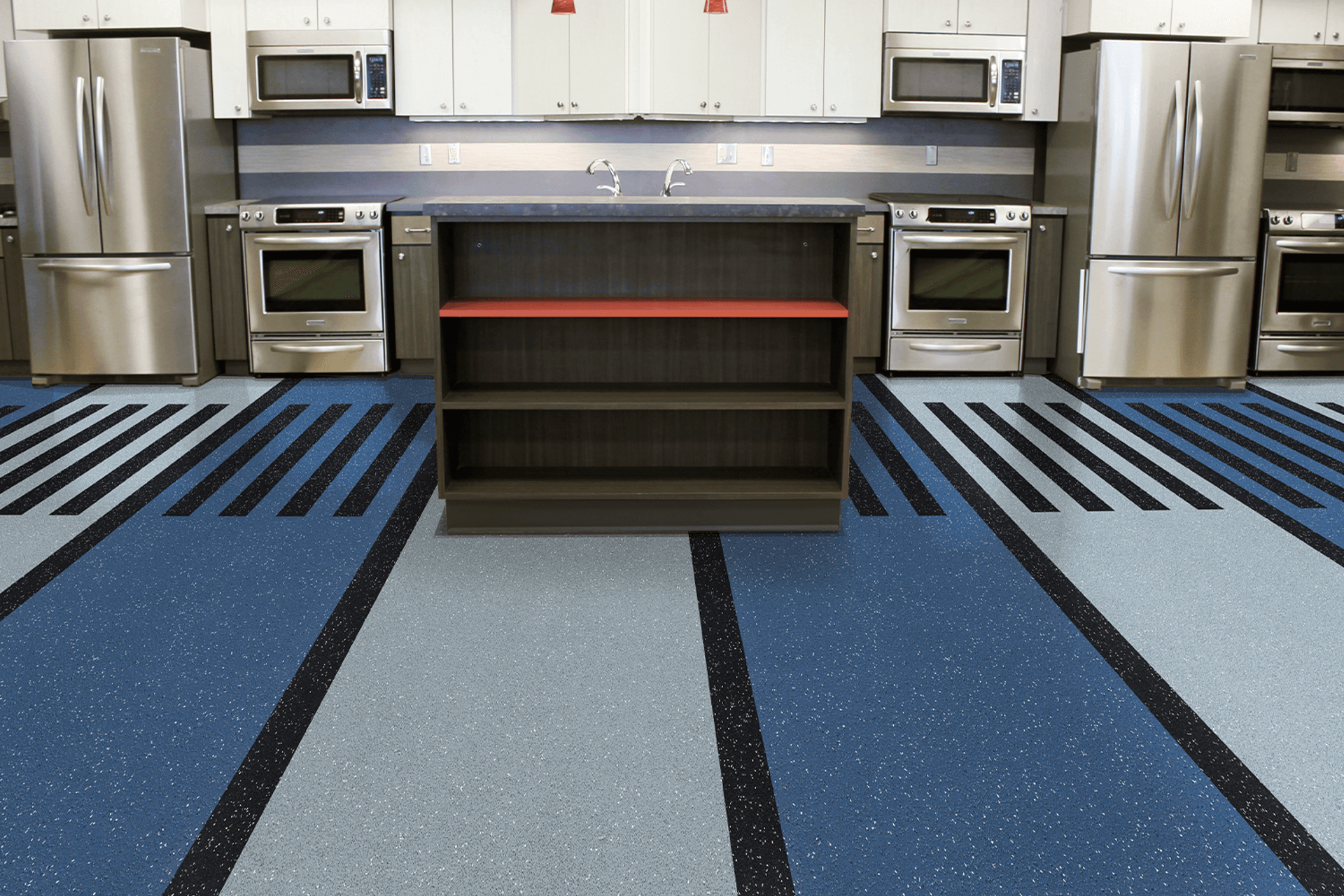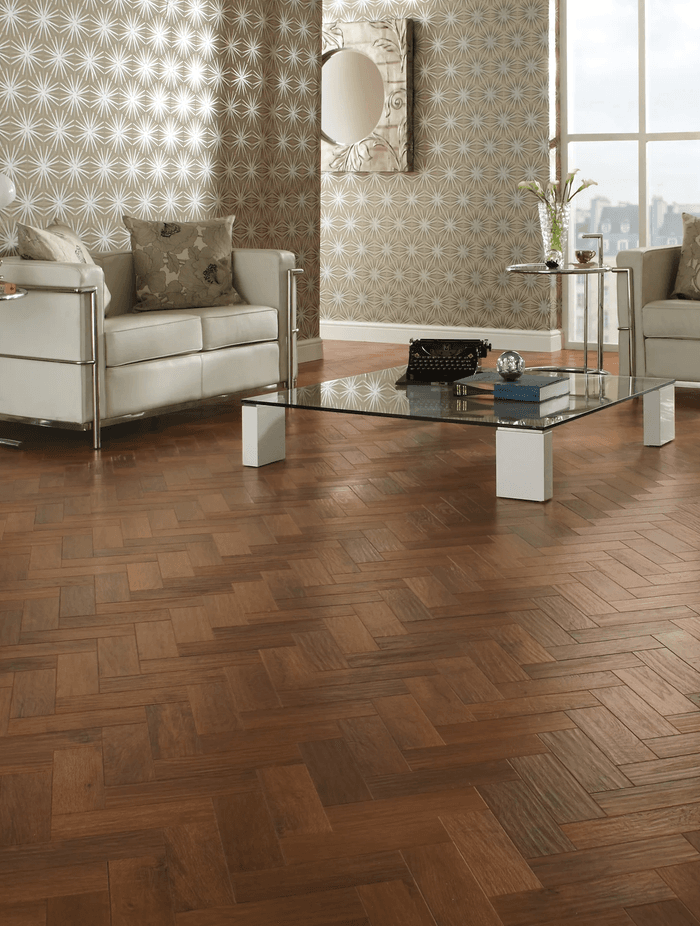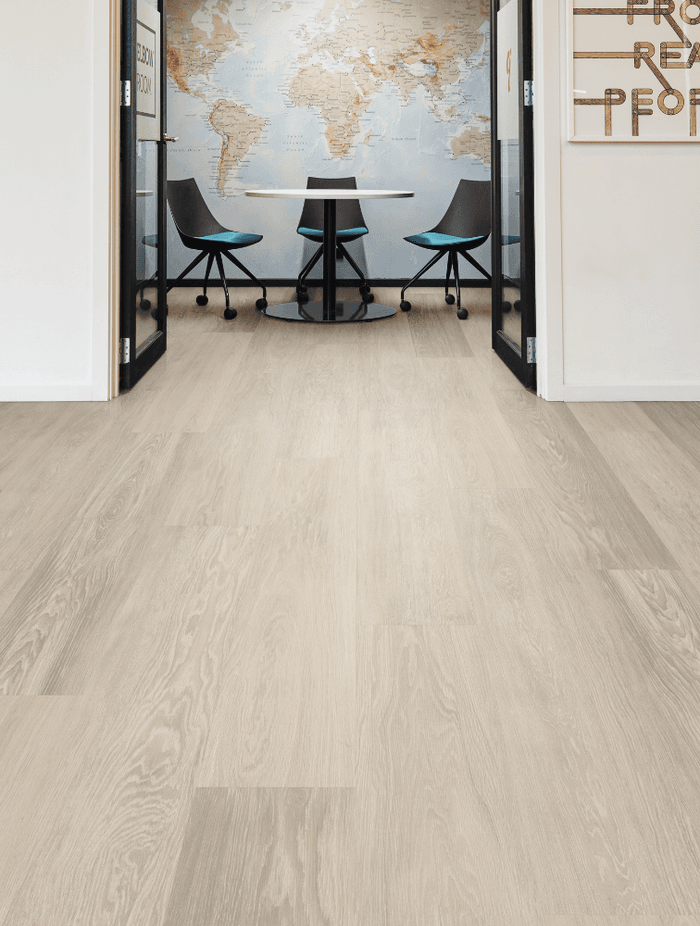Vinyl flooring price: a breakdown

The price of vinyl flooring can depend on the size of the area that requires flooring, the quality of the product, and the associated installation costs. In this guide, we’ll cover the average price of vinyl flooring in Australia and the types available.
What is the average price of vinyl flooring?
The average price of vinyl flooring in Australia ranges from $20 to $80+ per square metre, depending on the type of product chosen. Factors such as installation costs, quality of the product, and size of the area can all affect the overall price.
Factors affecting the cost of vinyl flooring
Type of vinyl flooring: there are several types of vinyl flooring, including sheet vinyl, vinyl tile (VCT), and luxury vinyl tile/plank (LVT/LVP). Sheet vinyl is often the most affordable option, while LVT/LVP tends to be more expensive due to its higher quality and more realistic appearance.
Size of the area: the total cost of vinyl flooring is also significantly influenced by the size of the area to be covered. Generally, vinyl flooring is priced per square meter, and thus, the larger the area, the higher the total cost.
Quality and brand: the quality of the vinyl material and the brand can impact the price. Higher quality vinyl, which is thicker and has better wear layers, will be more expensive. Premium brands often charge more for their products due to their reputation for quality.
Design and style: the complexity of the design and the style of the vinyl can also affect the price. Vinyl flooring that mimics the look of natural materials such as hardwood or stone tends to be more costly than simpler, patterned designs.
Underlayment and subfloor preparation: the condition of the subfloor and the need for an underlayment can influence the overall cost. If the subfloor requires extensive preparation or if a specific underlayment is needed for better moisture resistance or insulation, this will increase the cost.
Complexity of installation: the cost of installation can vary based on the complexity of the job. For example, installing vinyl planks or tiles can be more labour-intensive than laying down sheet vinyl, especially if the design involves intricate patterns or requires cutting around obstacles. You may be able to lay your vinyl flooring yourself, if not expect to pay between $30 - $60 an hour for professional installation.
Types of vinyl flooring
Here are the most common types of vinyl floor, and approximate pricing:
1. Sheet Vinyl Flooring
Sheet vinyl flooring is sold in large rolls that can be unrolled and cut to fit the specific dimensions of a room. It is known for its straightforward installation, and application in bathrooms and kitchens.
- Pros: Waterproof, easy to install, and offers a seamless look.
- Cons: Difficult to handle and install without professional help due to its large size.
Price: $7 to $70 per square metre
2. Vinyl Tile Flooring (VCT)
Vinyl Composition Tile (VCT) is made of coloured vinyl chips formed into solid tiles of varying thicknesses that are then installed with adhesive onto a floor. VCT is often used in commercial and institutional applications.
- Pros: Highly durable, offers design versatility, and is cost-effective for large areas.
- Cons: Requires regular maintenance, including stripping, waxing, and polishing.
Price: $9 to $42 per square metre
3. Vinyl Plank Flooring
Vinyl Plank Flooring offers a balance between affordability and the stylistic qualities of hardwood floors. It's designed to mimic the look of wood planks and is a popular choice for residential areas.
- Pros: Mimics hardwood floors, water-resistant, and easy to install.
- Cons: Quality varies, and some options may look less realistic than others.
Price: $20 to $60+ per square metre
3. Luxury Vinyl Tile (LVT)
Luxury Vinyl Tile mimics the look of natural materials like stone or wood but is more affordable and easier to maintain. LVT typically has a realistic photographic print coating and a clear protective layer.
- Pros: Realistic designs, comfortable underfoot, and water-resistant.
- Cons: Can be more expensive than other vinyl flooring options.
Price: $28 to $70 per square metre
4. Luxury Vinyl Plank (LVP)
Luxury Vinyl Plank is similar to LVT but comes in planks resembling hardwood floors. It's an excellent option for those who want the look of wood without the maintenance.
- Pros: Mimics hardwood floors, water-resistant, durable, and easy to install.
- Cons: Some products may look less realistic than actual wood.
Price: $28 to $70 per square metre
5. Peel and Stick Vinyl
Peel and stick vinyl tiles or planks come with an adhesive backing that makes installation straightforward. They can be a quick and easy update to any room.
- Pros: Easy to install, affordable, and suitable for DIY projects.
- Cons: May not adhere well to uneven surfaces and can wear out faster than other types.
Price: $10 to $40+ per square metre
6. WPC Vinyl Flooring
Wood Plastic Composite (WPC) vinyl flooring is a newer type of vinyl that includes a mixture of wood and plastic. WPC vinyl planks or tiles are thicker than standard vinyl and often come with a cork or foam underlayment.
- Pros: Waterproof, comfortable underfoot, and offers excellent noise reduction.
- Cons: Can be heavier than traditional vinyl.
7. SPC Vinyl Flooring
Stone Plastic Composite (SPC) vinyl flooring is similar to WPC but uses a stone-based core, making it more durable and stable than WPC. SPC is known for its high resistance to moisture and temperature changes.
- Pros: Extremely durable, waterproof, stable in extreme temperatures, and easy to install.
- Cons: Less comfortable underfoot compared to WPC vinyl.
Benefits of vinyl flooring
There are plenty of benefits vinyl flooring can bring, some of the top include:
Water Resistance: - most vinyl flooring is either water-resistant or completely waterproof, making it suitable for use in areas prone to moisture like bathrooms, kitchens, and basements.
Extremely realistic designs - modern vinyl flooring uses high-definition printing techniques to create extremely realistic designs. This technology allows for the replication of natural materials like hardwood and stone with impressive accuracy, including texture and colour variations.
Eco-friendly options - recent advancements in vinyl flooring include the development of products made from recycled materials, as well as those that are recyclable at the end of their lifecycle. Some manufacturers also focus on reducing volatile organic compounds (VOCs) to improve indoor air quality.
Sound absorption - thanks to its layered construction, vinyl flooring tends to absorb sound better than many other hard flooring options. This can significantly reduce noise levels in busy homes or commercial spaces.
Comfort underfoot - vinyl flooring often comes with a padded underlayer, making it softer and more comfortable to walk on compared to harder surfaces like ceramic tile or stone. This can be particularly appreciated in spaces where you spend a lot of time standing, such as kitchens.
Related article: Hybrid flooring: Pros, cons, types and applications
Installation process for vinyl flooring
There a few key steps to follow to ensure your vinyl floor installation goes smoothly:
Plan your layout - determine the direction you want the planks or tiles to run. Ideally, they should run parallel to the longest wall or, in some cases, towards the main source of light. Plan to avoid having too narrow pieces at the room's perimeter.
Install underlayment (if necessary) - some vinyl products come with a pre-attached underlayment, while others may require a separate underlayment layer. Follow the manufacturer's instructions regarding underlayment installation.
Start laying the planks or tiles - begin in a corner, leaving a gap (usually 1/4 inch) between the wall and the first row for expansion. This gap can be maintained using spacers. For click-lock vinyl, simply angle the new plank into the previous row's groove and click into place, ensuring a tight seam. For peel-and-stick or glue-down tiles, follow the specific adhesive instructions provided by the manufacturer.
Continue across the room - work row by row, cutting the last plank in each row to fit if necessary. Use the leftover piece from the end of one row to start the next row to minimize waste, ensuring the stagger pattern recommended by the manufacturer.
Fitting around obstacles - for pipes, columns, or irregular edges, measure and cut the vinyl flooring to fit around these obstacles accurately. A template made from cardboard can help in tracing complex cuts.
Finish the installation - install baseboards, thresholds, or transition strips to cover the expansion gap and provide a finished look. Do not fasten these through the vinyl flooring itself to allow for expansion and contraction.
Post-installation - follow any specific instructions for post-installation care, such as waiting a certain period before moving furniture back onto the flooring or cleaning.
Vinyl flooring maintenance tips
To keep your vinyl floor in top condition, follow these tips:
Sweep or vacuum regularly - to prevent dirt and grit from scratching the surface, sweep, dry mop, or vacuum your vinyl flooring regularly. Be sure to use a soft brush attachment when vacuuming to avoid damage.
Wet mopping - use a damp mop with warm water and a mild floor cleaner designed for vinyl flooring. Avoid using harsh chemicals or abrasive cleaners as they can damage the floor's surface. For routine cleaning, sometimes water alone is enough, especially if you clean spills and marks promptly.
Immediate spill clean-up - vinyl flooring is water-resistant, making it ideal for kitchens and bathrooms. However, to prevent potential staining or slipping, it's important to wipe up spills as soon as they happen. Use a soft cloth or paper towel to blot spills gently. For tougher stains, a solution of water and mild detergent can be effective. Avoid using abrasive scrubbers or steel wool as they can scratch the floor.
Use protective pads under furniture: To prevent scratches and indentations, place felt pads under the legs of furniture. This is particularly important for heavy furniture or items that are moved frequently.
Avoid rubber-backed mats - rubber can stain vinyl flooring, so choose rugs or mats that are labelled as "vinyl-safe." Make sure to clean underneath rugs regularly to prevent debris accumulation.
Frequently asked questions about vinyl flooring
How much does vinyl flooring cost?
Average vinyl flooring prices can be estimated at between $20 - $80+ per square metre.
Is vinyl flooring cheaper than hardwood flooring?
Yes, vinyl flooring is generally cheaper than hardwood flooring. Vinyl offers a cost-effective alternative with a wide range of styles and designs, while hardwood floors are prized for their natural beauty and materials but come at a higher price. If you're looking to strike a balance between cost and looks, consider an option like engineered wood flooring. It consists of a top layer of hardwood attached to multiple layers of other wood types, providing a look similar to hardwood but often at a lower cost.
What is the price different between vinyl and laminate flooring?
The price difference between vinyl and laminate flooring tends to be minimal, with both options being budget-friendly. The cost can vary depending on quality and design, but generally, they are comparable in price.
A versatile, hardy type of flooring
Vinyl flooring is an excellent option for residential and commercial properties; it's relatively affordable, lasts for years and can mimic various common floor styles, from hardwood to stone tiles.
View a range of vinyl flooring options from Australia's top providers on ArchiPro today




